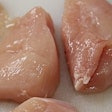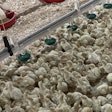No single factor is causing the current egg crisis in India with an increasingly wide supply demand gap and increasing retail prices now at record levels. Farm gate prices for eggs, as fixed by the NECC (National Egg Coordination Committee, Namakkal Chapter), were increased on August 20, 2008, to $4.60 per 100 eggs with the same sold in retail markets at $5.52 to $5.56 per 100 eggs.
Lower production, higher input costs, and sudden unseasonal demand for eggs, all on the back of continuous rains in southern Indian states where egg production is concentrated, are contributing to the record price increases said Singaraj, president of All India Poultry Products Exporters Association, talking to Financial Express.
Indian layer flocks produce for 72 weeks before replacement, but farmers have steadily failed to replace flocks from the beginning of this year onwards. Why India, with one of the biggest egg producers in the world with a huge export trade, especially to the Middle East, should suddenly go short of eggs appears to be a bit of a mystery. However, it was collapse of this export trade to the Middle East in January 2008 that started problems leading to this current shortfall in production.
Bird flu invariably gets the blame for production ups and downs. The West Bengal outbreak beginning in January 2008 had absolutely no direct effect on India’s overall egg supply but indirectly was catastrophic. Middle Eastern countries banned the import of all Indian eggs following the outbreak in West Bengal. What is happening now to egg supply and prices is exactly that predicted by industry leaders in January 2008 hard on the heels of the West Bengal bird flu outbreak.
Within days of OIE (World Organisation for Animal Health) listing India as a H5N1 affected country on January 16, 2008, a clutch of Middle East importing countries including UAE (United Arab Emirates), Yemen, Bahrain, Dubai, and Kuwait slapped bans on eggs from India, causing India’s exports to crash. On February 1, 2008, NECC chairwoman Anuradha Desai said India’s daily export of 10 million eggs had already shrunk to 4.5 million, representing a financial loss to producers of around $18 million.
Following imposition of these bans, egg prices in India crashed to $2.76 per 100, causing farms across the country to reduce replacement of layer flocks. Especially hard hit was the Namakkal zone in Tamil Nadu, dubbed the “egg hub” of India since it accounts for 90 percent of India’s egg exports.
Net result and continuing to this day are fewer layer flocks, and not only in southern India. According to Singaraj, layer farms across the country have been steadily reducing flock replacement so that the national layer flock now stands at 170-180 million compared with 200-210 million one year ago. Layer bird numbers in the Namakkal zone alone have fallen to 35 million birds from 42.5 million birds.
Bird flu and consequent import bans on India’s eggs are not the whole story because increases in feed costs are as much, if not more, to blame. Maize in the market yards is fetching $200.70 per tonne, while in Tamil Nadu and some parts of Karnataka, maize spot prices have risen to $250.30 per tonne. Other raw materials like soya extract surged to $552.04 per tonne from just $332.02 tonne one year ago. Sunflower extract price has doubled to $276.02 per tonne. Egg production costs stand at $4.37 per 100, said Singaraj.
The Indian media, including Newindpress, has pressed the poultry industry to justify its raising of egg prices to this record level. The increase, said Newindpress, is extreme because eggs do not normally rise in price at this time of the year. They are claiming that the industry led by big producers is just trying to recoup losses suffered earlier in the year due to bird flu and adverse market conditions caused by an unusually hot summer in many parts of India.
That said, small producers who market eggs (and broilers) through the market coordination system complain the price increase will not benefit them as there was no substantial increase in the procurement rates. And, these same small to medium size producers say they are heavily burdened by increased input costs including a doubling of feed prices over the last twelve months. Tamil Nadu Poultry Farmers Association president, R. Nallathambi, attributed the rise in price to an exorbitant increase in poultry feed prices.
Uncertainties in the egg market are a particular blow to India which clawed its way up to second top producer in the world with an estimated annual output of 37 billion eggs at the beginning of this year. Anuradha Desai estimates the value of India's poultry industry at $9 billion with direct and indirect employment to 3.5 million people. Chicken is a particularly important source of animal protein in India for the predominant Hindu population that does not eat beef and a large minority Muslim community that does not consume pork.
Bird flu is blamed for a wide variety of problems right or wrong. India’s latest bird flu outbreak in January 2008 was in the state of West Bengal state tucked away in the north east corner of the sub-continent bordering Bangladesh. Consequent culling of some 4-5 million birds mostly affected backyard flocks in West Bengal. The outbreak got the blame for India “needing” to import unprocessed poultry meat from Brazil and now the supply demand gap for eggs accompanied by sky high prices. Neither is as simple as first seems.

















